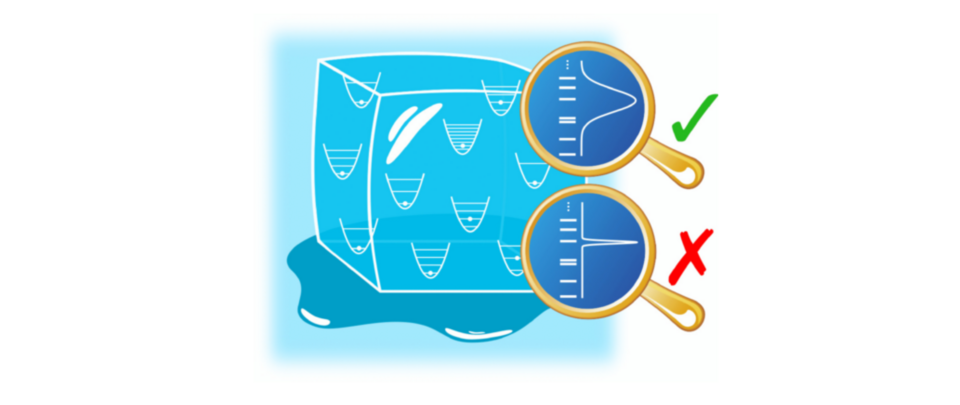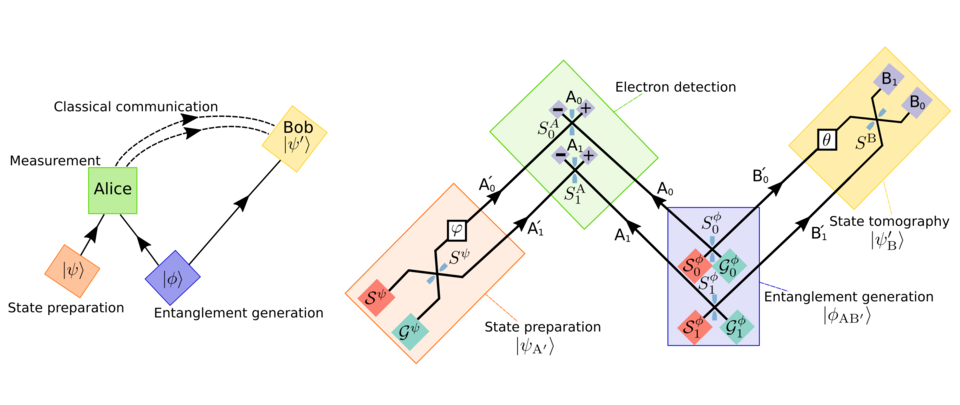Welcome to the Quantum Thermodynamics Group
The theory of thermodynamics was a driving force in the industrial revolution. By enabling the development of devices such as steam engines and refrigerators, it had a tremendous impact. At the nanoscale, where systems experience fluctuations and quantum effects, our thermodynamic understanding is still being expanded. Our group is a part of this exciting development which promises to produce important contributions to emerging nano- and quantum-technologies.
New Publications and Preprints
Time-resolved Stochastic Dynamics of Quantum Thermal Machines

Phys. Rev. Lett. 134, 150402 (2025)
Steady-state quantum thermal machines are typically characterized by a continuous flow of heat between different reservoirs. However, at the level of discrete stochastic realizations, heat flow is unraveled as a series of abrupt quantum jumps, each representing the exchange of finite quanta with the environment. In this work, we present a framework that resolves the dynamics of quantum thermal machines into cycles that are classified as engine-like, cooling-like, or idle. We explore the statistics of each cycle type and its duration, enabling us to determine both the fraction of cycles useful for thermodynamic tasks and the average waiting time between cycles of the same type. Our framework presents a novel approach in characterizing thermal machines, with significant relevance to modern experiments, such as mesoscopic transport using quantum dots.
Wigner-function formalism for the detection of single microwave pulses in a resonator-coupled double quantum dot

Phys. Rev. Research 7, 013305 (2025)
Semiconductor double quantum dots (DQD) coupled to superconducting microwave resonators offer a promising platform for the detection of single microwave photons. In previous works, the photodetection was studied for a monochromatic source of microwave photons. Here, we theoretically analyze the photodetection of single microwave pulses. The photodetection in this case can be seen as a non-linear filtering process of an incoming signal, the pulse, to an outgoing one, the photocurrent. This analogy to signal processing motivated the derivation of a Wigner-function formalism which provides a compelling visualization of the time and frequency properties of the photodetector for low intensities. We find a trade-off between detecting the time and the frequency of the incoming photons in agreement with the time-energy uncertainty relation. As the intensity of the source increases, the photodetection is influenced by coherent Rabi oscillations of the DQD. Our findings give insight into the time-dependent properties of microwave photons interacting with electrons in a DQD-resonator hybrid system and provide guidance for experiments on single microwave pulse detection.
Continuous feedback protocols for cooling and trapping a quantum harmonic oscillator

Phys. Rev. E 111, 014152 (2025)
Quantum technologies and experiments often require preparing systems in low-temperature states. Here, we investigate cooling schemes using feedback protocols modeled with a Quantum Fokker-Planck Master Equation (QFPME) recently derived by Annby-Andersson et. al. [Phys. Rev. Lett. 129, 050401 (2022)]. This equation describes systems under continuous weak measurements, with feedback based on the outcome of these measurements. We apply this formalism to study the cooling and trapping of a harmonic oscillator for several protocols based on position and/or momentum measurements. We find that the protocols can cool the oscillator down to, or close to, the ground state for suitable choices of parameters. Our analysis provides an analytically solvable case study of quantum measurement and feedback and illustrates the application of the QFPME to continuous quantum systems.
Coherence of an Electronic Two-Level System under Continuous Charge Sensing by a Quantum Dot Detector

Phys. Rev. Lett. 134, 023601 (2025)
We investigate experimentally the quantum coherence of an electronic two-level system in a double quantum dot under continuous charge detection. The charge-state of the two-level system is monitored by a capacitively coupled single quantum dot detector that imposes a back-action effect to the system. The measured back-action is well described by an additional decoherence rate, approximately linearly proportional to the detector electron tunneling rate. We provide a model for the decoherence rate arising due to level detuning fluctuations induced by detector charge fluctuations. The theory predicts a factor of two lower decoherence rate than observed in the experiment, suggesting the need for a more elaborate theory accounting for additional sources of decoherence.
Role of Quantum Coherence in Kinetic Uncertainty Relations

Phys. Rev. Lett. 134, 020401 (2025)
The Kinetic Uncertainty Relation (KUR) bounds the signal-to-noise ratio of stochastic currents in terms of the number of transitions per unit time, known as the dynamical activity. This bound was derived in a classical context, and can be violated in the quantum regime due to coherent effects. However, the precise connection between KUR violations and quantum coherence has so far remained elusive, despite significant investigation. In this work, we solve this problem by deriving a modified bound that exactly pinpoints how, and when, coherence might lead to KUR violations. Our bound is sensitive to the specific kind of unraveling of the quantum master equation. It therefore allows one to compare quantum jumps and quantum diffusion, and understand, in each case, how quantum coherence affects fluctuations. We illustrate our result on a double quantum dot, where the electron current is monitored either by electron jump detection or with continuous diffusive charge measurement.
Quantum Fluctuation Theorem for Arbitrary Measurement and Feedback Schemes

Phys. Rev. Lett. 133, 140401 (2024)
Fluctuation theorems and the second law of thermodynamics are powerful relations constraining the behavior of out-of-equilibrium systems. While there exist generalizations of these relations to feedback controlled quantum systems, their applicability is limited, in particular when considering strong and continuous measurements. In this letter, we overcome this shortcoming by deriving a novel fluctuation theorem, and the associated second law of information thermodynamics, which remain applicable in arbitrary feedback control scenarios. In our second law, the entropy production is bounded by the coarse-grained entropy production which is inferrable from the measurement outcomes, an experimentally accessible quantity that does not diverge even under strong continuous measurements. We illustrate our results by a qubit undergoing discrete and continuous measurement, where our approach provides a useful bound on the entropy production for all measurement strengths.
Realization of a Coherent and Efficient One-Dimensional Atom

Phys. Rev. Lett. 133, 083602 (2024), Physics, Editor's suggestion
A single-photon sifter: Light is made of discrete quanta known as photons. Typically, photons cluster together, described in quantum optics as “bunching”. This is a feature of sun-light or the light emitted by a light bulb. Here, we sift single photons from a source. Single photons emerge one by one at the output, described as “anti-bunching”. At the heart of our single-photon sifter is a single artificial atom, a semiconductor quantum dot. Photons do not interact with each other. Our system behaves as if they do. Our work constitutes an important building block in the realization of quantum nonlinear optics, with applications ranging from quantum communication and information processing to microscopy and quantum sensing.
Optimal time estimation and the clock uncertainty relation for stochastic processes

arXiv:2406.19450, NewScientist
Time estimation is a fundamental task that underpins precision measurement, global navigation systems, financial markets, and the organisation of everyday life. Many biological processes also depend on time estimation by nanoscale clocks, whose performance can be significantly impacted by random fluctuations. In this work, we formulate the problem of optimal time estimation for Markovian stochastic processes, and present its general solution in the asymptotic (long-time) limit. Specifically, we obtain a tight upper bound on the precision of any time estimate constructed from sustained observations of a classical, Markovian jump process. This bound is controlled by the mean residual time, i.e. the expected wait before the first jump is observed. As a consequence, we obtain a universal bound on the signal-to-noise ratio of arbitrary currents and counting observables in the steady state. This bound is similar in spirit to the kinetic uncertainty relation but provably tighter, and we explicitly construct the counting observables that saturate it. Our results establish ultimate precision limits for an important class of observables in non-equilibrium systems, and demonstrate that the mean residual time, not the dynamical activity, is the measure of freneticity that tightly constrains fluctuations far from equilibrium.
High-efficiency microwave photodetection by cavity coupled double dots with single cavity-photon sensitivity

We present a superconducting cavity-coupled double quantum dot (DQD) photodiode that achieves a maximum photon-to-electron conversion efficiency of 25% in the microwave domain. With a higher-quality-factor cavity and improved device design to prevent photon leakages through unwanted pathways, our device measures microwave signals down to 100 aW power level and achieves sensitivity to probe microwave signals with one photon at a time in the cavity. We analyze the photodiode operation using Jaynes-Cummings input-output theory, identifying the key improvements of stronger cavity-DQD coupling needed to achieve near-unity photodetection efficiency. The results presented in this work represent a crucial advancement toward near unity microwave photodetection efficiency with single cavity-photon sensitivity for studies of photon statistics in the microwave range and applications related to quantum information processing.
Maxwell's demon across the quantum-to-classical transition

Phys. Rev. Research 6, 043216 (2024)
In scenarios coined Maxwell's demon, information on microscopic degrees of freedom is used to seemingly violate the second law of thermodynamics. This has been studied in the classical as well as the quantum domain. In this paper, we study an implementation of Maxwell's demon that can operate in both domains. In particular, we investigate information-to-work conversion over the quantum-to-classical transition. The demon continuously measures the charge state of a double quantum dot, and uses this information to guide electrons against a voltage bias by tuning the on-site energies of the dots. Coherent tunneling between the dots allows for the buildup of quantum coherence in the system. Under strong measurements, the coherence is suppressed, and the system is well-described by a classical model. As the measurement strength is further increased, the Zeno effect prohibits interdot tunneling. A Zeno-like effect is also observed for weak measurements, where measurement errors lead to fluctuations in the on-site energies, dephasing the system. We anticipate similar behaviors in other quantum systems under continuous measurement and feedback control, making our results relevant for implementations in quantum technology and quantum control.
Current fluctuations in open quantum systems: Bridging the gap between quantum continuous measurements and full counting statistics

Continuously measured quantum systems are characterized by an output current, in the form of a stochastic and correlated time series which conveys crucial information about the underlying quantum system. The many tools used to describe current fluctuations are scattered across different communities: quantum opticians often use stochastic master equations, while a prevalent approach in condensed matter physics is provided by full counting statistics. These, however, are simply different sides of the same coin. Our goal with this tutorial is to provide a unified toolbox for describing current fluctuations. This not only provides novel insights, by bringing together different fields in physics, but also yields various analytical and numerical tools for computing quantities of interest. We illustrate our results with various pedagogical examples, and connect them with topical fields of research, such as waiting-time statistics, quantum metrology, thermodynamic uncertainty relations, quantum point contacts and Maxwell's demons.
Decoherence in a crystal-phase defined double quantum dot charge qubit strongly coupled to a high-impedance resonator
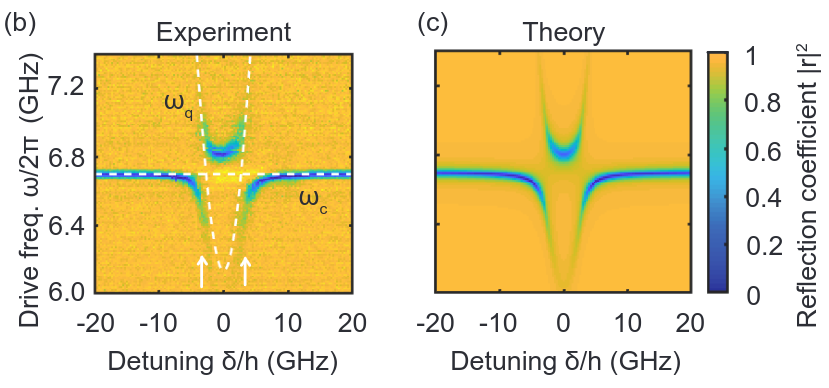
Phys. Rev. Research 6, 043134 (2024)
Decoherence of a charge qubit is usually credited to charge noise in the environment. Here we show that charge noise may not be the limiting factor for the qubit coherence. To this end, we study coherence properties of a crystal-phase defined semiconductor nanowire double quantum dot (DQD) charge qubit strongly coupled to a high-impedance resonator using radio-frequency reflectometry. Response of this hybrid system is measured both at a charge noise sensitive operation point (with finite DQD detuning) and at an insensitive point (so-called sweet spot with zero detuning). A theoretical model based on the Jaynes-Cummings Hamiltonian matches the experimental results well and yields only a 10% difference in decoherence rates between the two cases, despite that the sensitivity to detuning charge noise differs by a factor of 5. Therefore, the charge noise is not limiting the coherence in this experiment with this type of semiconducting nanowire qubits.
Microwave power harvesting using resonator-coupled double quantum dot photodiode
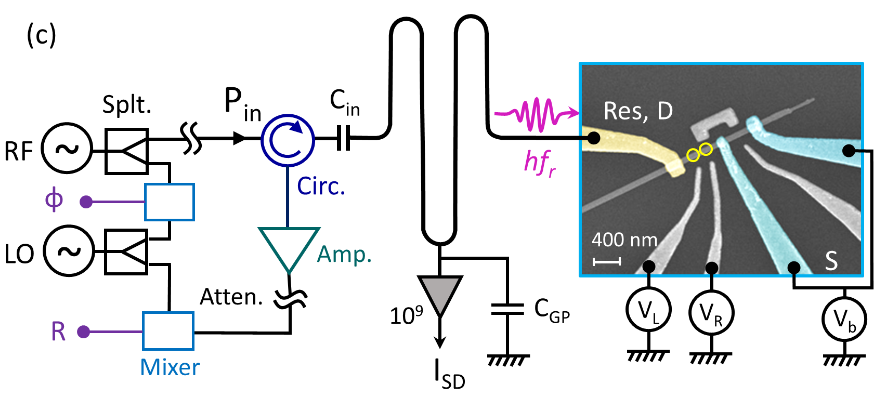
Phys. Rev. B 109, L081403 (2024)
We demonstrate a microwave power-to-electrical energy conversion in a resonator-coupled double quantum dot system. The system operated as a photodiode, converts individual microwave photons to electrons tunneling through the double dot, resulting in an electrical current flowing against the applied voltage bias at input powers down to 1 femto-watt level. The device attains a maximum power harvesting efficiency of 2%, with the photon-to-electron conversion efficiency reaching 12%. We analyze the device operation in both the linear and non-linear microwave power response regimes and compare the results to theoretical predictions, finding good agreement.
Strong coupling between a microwave photon and a singlet-triplet qubit
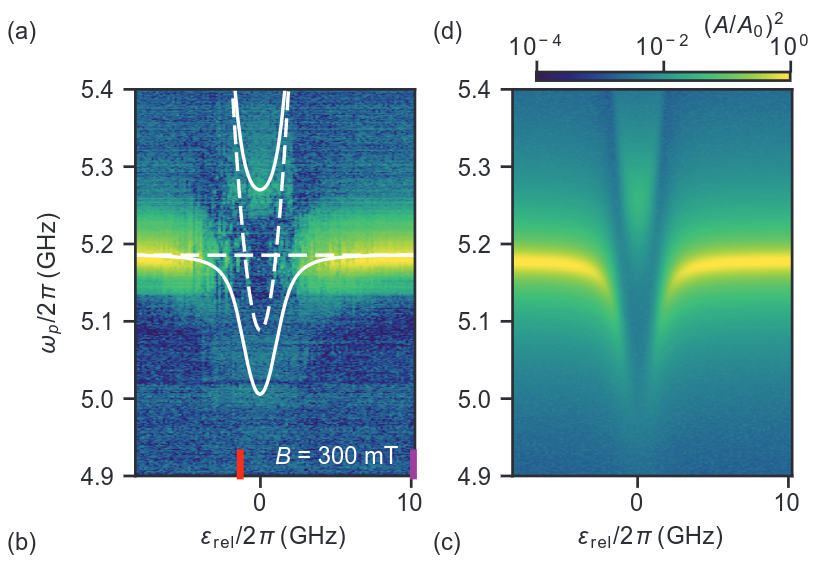
Tremendous progress in few-qubit quantum processing has been achieved lately using superconducting resonators coupled to gate voltage defined quantum dots. While the strong coupling regime has been demonstrated recently for odd charge parity flopping mode spin qubits, first attempts towards coupling a resonator to even charge parity singlet-triplet spin qubits have resulted only in weak spin-photon coupling strengths. Here, we integrate a zincblende InAs nanowire double quantum dot with strong spin-orbit interaction in a magnetic-field resilient, high-quality resonator. In contrast to conventional strategies, the quantum confinement is achieved using deterministically grown wurtzite tunnel barriers without resorting to electrical gating. Our experiments on even charge parity states and at large magnetic fields, allow to identify the relevant spin states and to measure the spin decoherence rates and spin-photon coupling strengths. Most importantly, we find an anti-crossing between the resonator mode in the single photon limit and a singlet-triplet qubit with an electron spin-photon coupling strength of g/2π=139±4 MHz. Combined with the resonator decay rate κ/2π=19.8±0.2 MHz and the qubit dephasing rate γ/2π=116±7 MHz, our system achieves the strong coupling regime in which the coherent coupling exceeds qubit and resonator linewidth. These results pave the way towards large-scale quantum system based on singlet-triplet qubits.
Stochastic thermodynamics of a quantum dot coupled to a finite-size reservoir
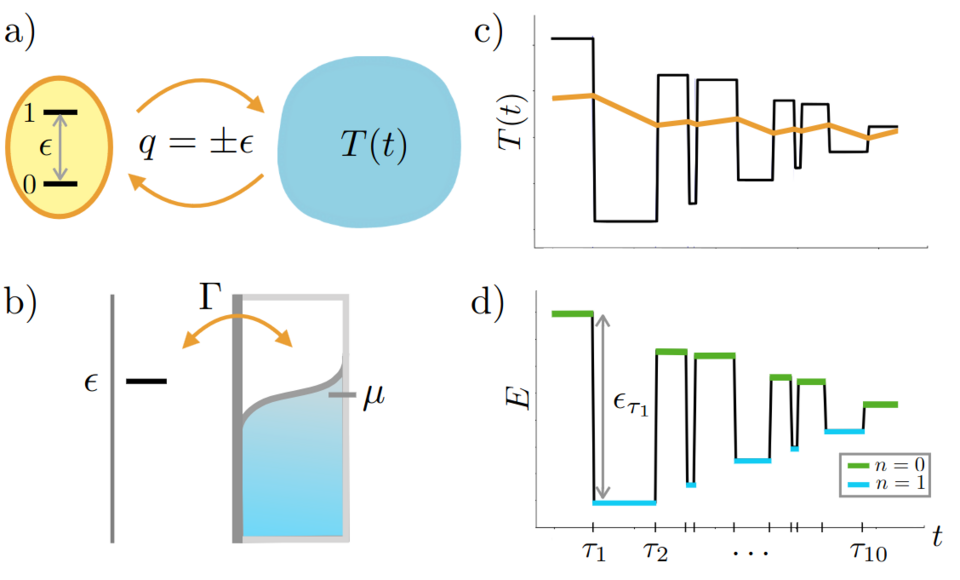
Phys. Rev. Lett. 131, 220405 (2023)
In nano-scale systems coupled to finite-size reservoirs, the reservoir temperature may fluctuate due to heat exchange between the system and the reservoirs. To date, a stochastic thermodynamic analysis of heat, work and entropy production in such systems is however missing. Here we fill this gap by analyzing a single-level quantum dot tunnel coupled to a finite-size electronic reservoir. The system dynamics is described by a Markovian master equation, depending on the fluctuating temperature of the reservoir. Based on a fluctuation theorem, we identify the appropriate entropy production that results in a thermodynamically consistent statistical description. We illustrate our results by analyzing the work production for a finite-size reservoir Szilard engine.
Probe thermometry with continuous measurements
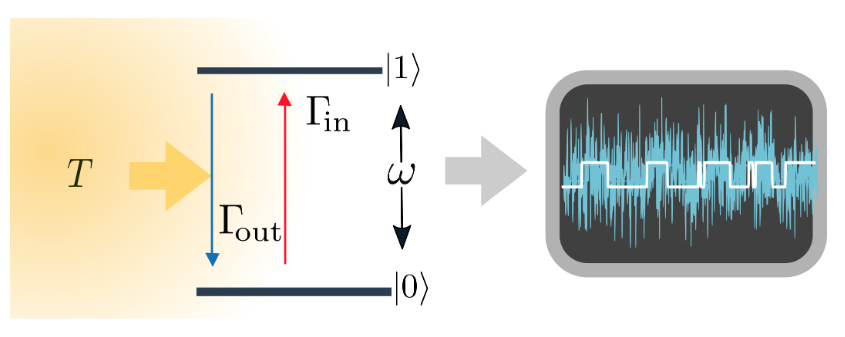
New J. Phys. 25, 123009 (2023)
Temperature estimation plays a vital role across natural sciences. A standard approach is provided by probe thermometry, where a probe is brought into contact with the sample and examined after a certain amount of time has passed. In situations where, for example, preparation of the probe is non-trivial or total measurement time of the experiment is the main resource that must be optimised, continuously monitoring the probe may be preferred. Here, we consider a minimal model, where the probe is provided by a two-level system coupled to a thermal reservoir. Monitoring thermally activated transitions enables real-time estimation of temperature with increasing accuracy over time. Within this framework we comprehensively investigate thermometry in both bosonic and fermionic environments employing a Bayesian approach. Furthermore, we explore adaptive strategies and find a significant improvement on the precision. Additionally, we examine the impact of noise and find that adaptive strategies may suffer more than non-adaptive ones for short observation times. While our main focus is on thermometry, our results are easily extended to the estimation of other environmental parameters, such as chemical potentials and transition rates.
Optical coherent feedback control of a mechanical oscillator
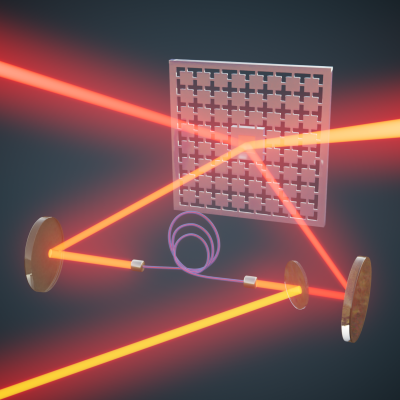
Phys. Rev. X 13, 021023 (2023)
Feedback is a powerful and ubiquitous technique both in classical and quantum system control. In its standard implementation it relies on measuring the state of a system, classically processing and feeding back the extracted information. In quantum physics, however, measurements not only read out the state of the system, but also modify it irreversibly. A different kind of feedback which coherently processes and feeds back quantum signals without actually measuring the system is possible. This is known as coherent feedback. Here, we report on the realization of an optical coherent feedback platform to control the motional state of a nanomechanical membrane in an optical cavity. The coherent feedback loop consists of a light field interacting twice with the same mechanical mode through different cavity modes, without any measurement taking place. Our theoretical analysis provides the optimal cooling conditions, showing that this new technique enables ground-state cooling. Experimentally, we show that we can cool the membrane to a state with n=4.89±0.14 phonons (480μK) in a 20K environment.
The Wave-Particle Duality in a Quantum Heat Engine
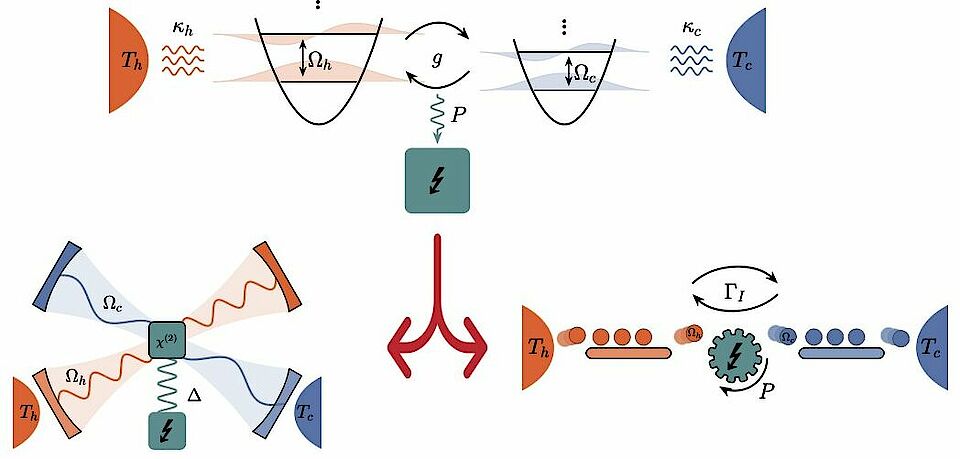
Phys. Rev. Research 5, L042007 (2023)
According to the wave-particle duality (WPD), quantum systems show both particle- and wave-like behavior, and cannot be described using only one of these classical concepts. Identifying quantum features that cannot be reproduced by any classical means is key for quantum technology. This task is often pursued by comparing the quantum system of interest to a suitable classical counterpart. However, the WPD implies that a comparison to a single classical model is generally insufficient; at least one wave and one particle model should be considered. Here we exploit this insight and contrast a bosonic quantum heat engine with two classical counterparts, one based on waves and one based on particles. While both classical models reproduce the average output power of the quantum engine, neither reproduces its fluctuations. The wave model fails to capture the vacuum fluctuations while the particle model cannot reproduce bunching to its full extent. We find regimes where wave and particle descriptions agree with the quantum one, as well as a regime where neither classical model is adequate, revealing the role of the WPD in non-equilibrium bosonic transport.
Information-to-work conversion in single-molecule experiments: From discrete to continuous feedback
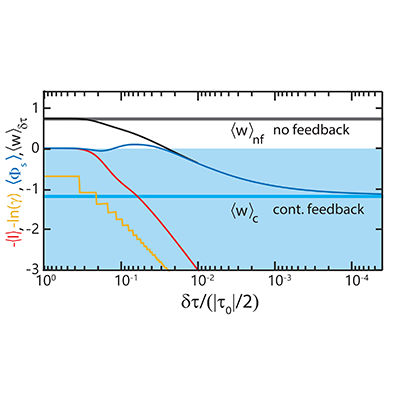
Phys. Rev. E 107, L052104 (2023)
Editor's suggestion
We theoretically investigate the extractable work in single molecule unfolding-folding experiments with applied feedback. Using a simple two-state model, we obtain a description of the full work distribution from discrete to continuous feedback. The effect of the feedback is captured by a detailed fluctuation theorem, accounting for the information aquired. We find analytical expressions for the average work extraction as well as an experimentally measurable bound thereof, which becomes tight in the continuous feedback limit. We further determine the parameters for maximal power or rate of work extraction. Although our two-state model only depends on a single effective transition rate, we find qualitative agreement with Monte Carlo simulations of DNA hairpin unfolding-folding dynamics.
Entanglement and thermo-kinetic uncertainty relations in coherent mesoscopic transport
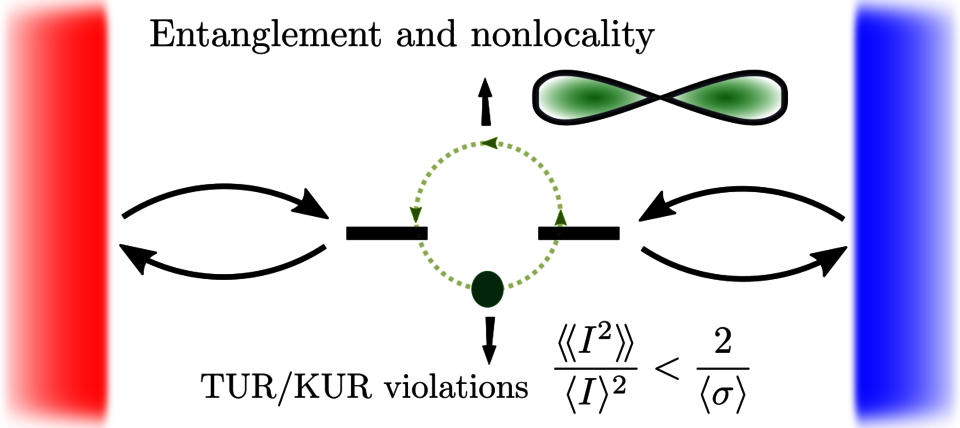
Phys. Rev. Research 5, 023155 (2023)
A deeper understanding of the differences between quantum and classical dynamics promises great potential for emerging technologies. Nevertheless, some aspects remain poorly understood, particularly concerning the role of quantum coherence in open quantum systems. On the one hand, coherence leads to entanglement and even nonlocality. On the other, it may lead to a suppression of fluctuations, causing violations of thermo-kinetic uncertainty relations (TUR/KUR) that are valid for classical processes. These represent two different manifestations of coherence, one depending only on the state of the system (static) and one depending on two-time correlation functions (dynamical). Here we employ these manifestations of coherence to determine when mesoscopic quantum transport can be captured by a classical model based on stochastic jumps, and when such a model breaks down implying nonclassical behavior. To this end, we focus on a minimal model of a double quantum dot coupled to two thermal reservoirs. In this system, quantum tunneling induces Rabi oscillations and results in both entanglement and nonlocality, as well as TUR/KUR violations. These effects, which describe the breakdown of a classical description, are accompanied by a peak in coherence. Our results provide guiding principles for the design of out-of-equilibrium devices that exhibit nonclassical behavior.
Quantum Fokker-Planck Master Equation for Continuous Feedback Control
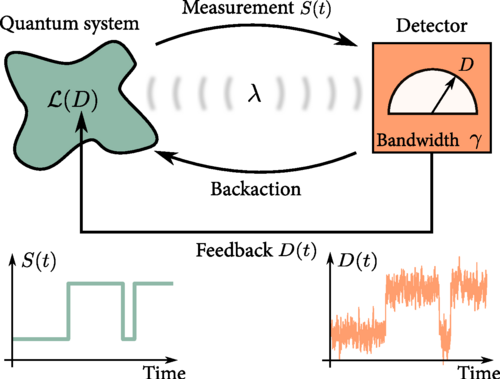
Phys. Rev. Lett. 129, 050401 (2022)
Measurement and feedback control are essential features of quantum science, with applications ranging from quantum technology protocols to information-to-work conversion in quantum thermodynamics. Theoretical descriptions of feedback control are typically given in terms of stochastic equations requiring numerical solutions, or are limited to linear feedback protocols. Here we present a formalism for continuous quantum measurement and feedback, both linear and nonlinear. Our main result is a quantum Fokker-Planck master equation describing the joint dynamics of a quantum system and a detector with finite bandwidth. For fast measurements, we derive a Markovian master equation for the system alone, amenable to analytical treatment. We illustrate our formalism by investigating two basic information engines, one quantum and one classical.
Full counting statistics of the photocurrent through a double quantum dot embedded in a driven microwave resonator

Phys. Rev. B 106, 205135 (2022)
Detection of single, itinerant microwave photons is an important functionality for emerging quantum technology applications as well as of fundamental interest in quantum thermodynamics experiments. Here we theoretically investigate the fluctuations of the photocurrent in a photodetector consisting of a double quantum dot coupled to a microwave resonator. We find that for ideal, unity efficiency detection, the fluctuations of the charge current reproduce the Poisson statistics of the incoming photons. Additionall, the finite-frequency noise gives insight into the short-time behavior of the detector. Our results give novel insight into microwave photon-electron interactions in hybrid dot-resonator systems and provide guidance for further experiments on continuous detection of single microwave photons.
Probabilistically violating the first law of thermodynamics in a quantum heat engine
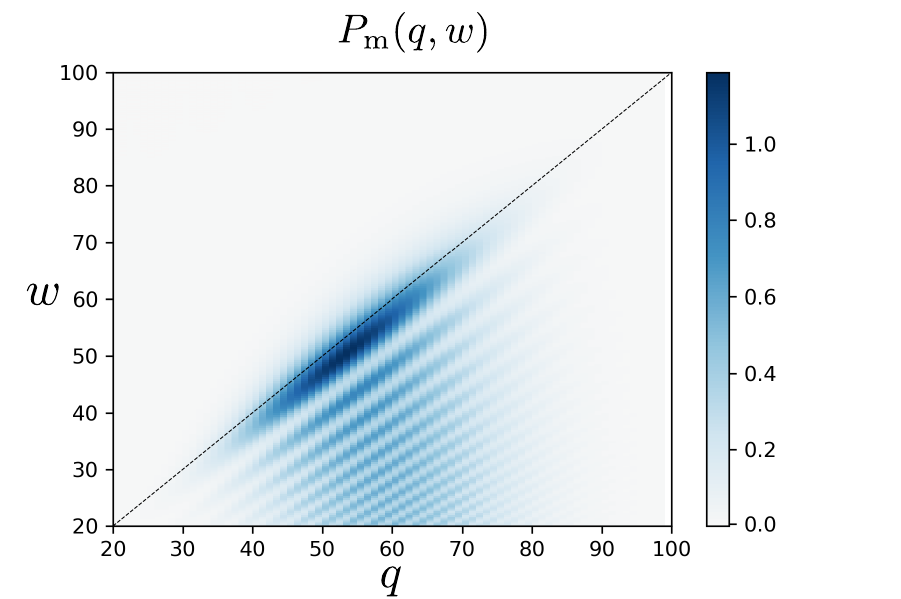
Fluctuations of thermodynamic observables, such as heat and work, contain relevant information on the underlying physical process. These fluctuations are however not taken into account in the traditional laws of thermodynamics. While the second law is extended to fluctuating systems by the celebrated fluctuation theorems, the first law is generally believed to hold even in the presence of fluctuations. Here we show that in the presence of quantum fluctuations, also the first law of thermodynamics may break down. To illustrate our results, we provide a detailed case-study of work and heat fluctuations in a quantum heat engine based on a circuit QED architecture.
A thermodynamically consistent Markovian master equation beyond the secular approximation

New J. Phys. 23, 123013 (2021)
Markovian master equations provide a versatile tool for describing open quantum systems when memory effects of the environment may be neglected. As these equations are of an approximate nature, they often do not respect the laws of thermodynamics when no secular approximation is performed in their derivation. Here we introduce a Markovian master equation that is thermodynamically consistent and provides an accurate description whenever memory effects can be neglected. Our results enable a thermodynamically consistent description of a variety of systems where the secular approximation breaks down.
Efficient and continuous microwave photoconversion in hybrid cavity-semiconductor nanowire double quantum dot diodes
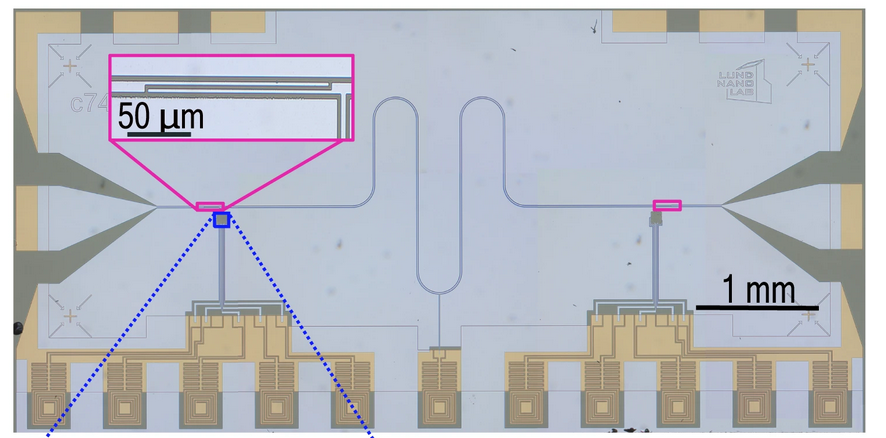
Converting incoming photons to electrical current is the key operation principle of optical photodetectors and it enables a host of emerging quantum information technologies. Here we demonstrate how microwave photons can be efficiently and continuously converted to electrical current in a high-quality, semiconducting nanowire double quantum dot resonantly coupled to a cavity. In our photodiode device, an absorbed photon gives rise to a single electron tunneling through the double dot, with a conversion efficiency reaching 6%.
Violating the thermodynamic uncertainty relation in the three-level maser
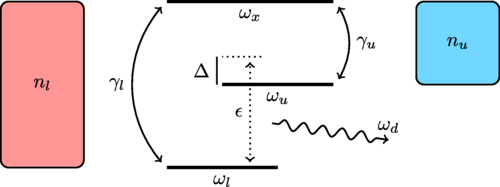
Phys. Rev. E 104, L012103 (2021)
The Thermodynamic Uncertainty Relation (TUR), a trade-off between power, efficiency, and low fluctuations, can be violated in the prototypical Scovil and Schulz-duBois maser. Comparing this maser to a classical analogue sheds light onto the relation between TUR violations and quantum coherence. Our results indicate that the coherent nature of the dynamics responsible for TUR violations is not encoded in the off-diagonal elements of the steady state density matrix.
News
16 April 2025
Qiuhan Wang and Gabriel Steiner started to work on their master theses in our group. Welcome!
29 October 2024

We had a group event where we worked on Project Euler challenges in the morning, then went to see the underground river Birsig in Basel, and finally visited the Brauerei Fischerstube, a local brewery.
18 September 2024
Max Schrauwen defended his Bachelor thesis. Congratulations!
17 September 2024
Brennan Hughes started to work on his master thesis in our group. Welcome!
13 September 2024
Kacper and Patrick presented at the Time in Quantum Thermodynamics conference in Slovakia.
3 September 2024
Nadine defended her Master thesis, congratulations!
24 July 2024
Danial defended his Master thesis, congratulations!
17 June 2024
Bradley Longstaff started a postdoc position in our group and Max Schrauwen started his Bachelor thesis, welcome!
24 May 2024
Björn Annby-Andersson, co-supervised by Patrick, defended his thesis, congratulations!
16 May 2024
Sander defended his Master thesis, congratulations!
1 May 2024
Matteo started a new Postdoc position at Collège de France, Paris. We wish you all the best!
7 March 2024
Patrick presented work on the thermodynamics of information at the APS March Meeting in Minneapolis.
6 February 2024
Patrick presented work on the thermodynamics of information at the University of Freiburg.
15 January 2024
Jan Neuser started to work on his master thesis in our group. Welcome!
13 December 2023
Patrick presented at the CMONS 2023 workshop in Warsaw.
05 October 2023
Marcelo's first paper during his PhD is published, congratulations!
26 - 27 September 2023
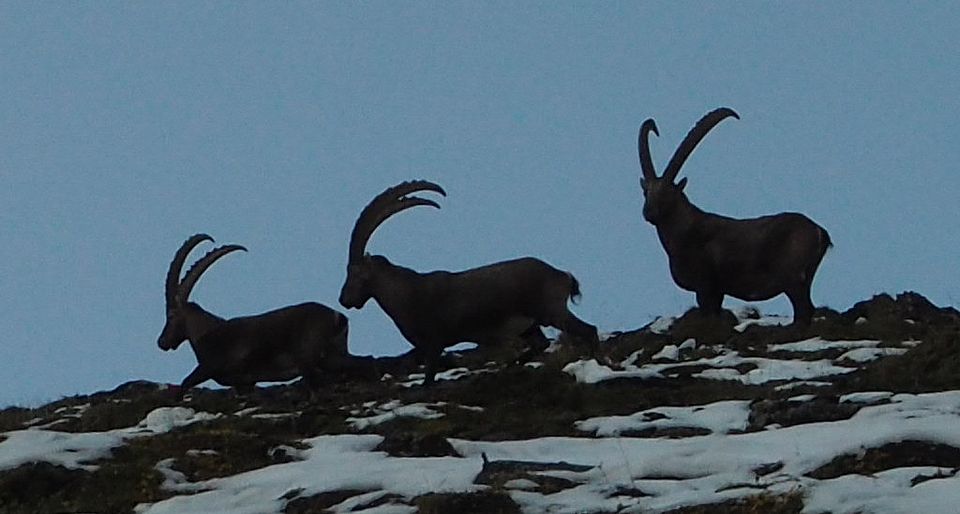
We went on a two-day Hike from Lauterbrunnen via Rotstockhütte over the Sefinafurgga to Griesalp. On the way we were met by a pack of alpine ibex.
18 September 2023
Nadine Lenke started to work on her master thesis in our group. Welcome!
15 September 2023
Joël Aschwanden defended his thesis entitled The thermodynamics of continuous feedback control: Case studies based on the quantum Fokker-Planck master equation. Congratulations!
05 - 07 September 2023
Aaron, Marcelo, and Kacper present at the Joint Annual Meeting of the SPS and ÖPG in Basel and Patrick gave an invited talk at the CMD30 in Milan.
17 August 2023
Patrick presented at the Quantum Thermodynamics Conference in Vienna.
06 June 2023
Kacper's first paper during his PhD is published, congratulations!
12 May 2023
Patrick presented at the Flat Club at the University of Geneva.
17 March 2023
Patrick presented at the first edition of the Quantum Seminar from EPFL's Center for Quantum Science and Engineering
07 March 2023
Sander finished his master project entitled Fully quantum description of a three level maser, driven by a thermal bath. Congratulations!
27 February 2023
Patrick was selected as an Outstanding Referee of the Physical Review journals, congratulations!
25-27 January 2023
Patrick will lecture at the workshop Nanoscience in the Snow.
01 January 2023
After finishing his Master thesis with the best grade, Aaron Daniel started his PhD in our group, congratulations!
03 October 2022
Joël Aschwanden started to work on his master thesis in our group. Welcome!
6 September 2022
Patrick is co-organizing the Young Faculty Meeting for the Swiss Academy of Sciences, Platform Mathematics, Astronomy and Physics.
22 July 2022
Follow us on our new Twitter account: @QTD_Basel.
01 July 2022
Saulo Moreira from Lund University presented a joint work with Patrick on the thermodynamics of a quantum dot coupled to a finite sized reservoir at the Quantum Thermodynamics Conference 2022. Find the video here.
15 March 2022
Aaron Daniel started to work on his master thesis in our group. Welcome!
16 February 2022
Patrick Potts was awarded the IOP Trusted Reviewer Status.
31 January - 04 February 2022
Patrick Potts presented at the workshop Openness as a resource: Accessing new quantum states with dissipative mechanisms.
07 December 2021
Patrick Potts is featured in an SNI Insight article.
15 October 2021
Matteo Brunelli started a Postdoc in the Quantum Thermodynamics Group. Welcome!
15 September 2021
Kacper Prech started his PhD in the Quantum Thermodynamics Group. Welcome!
23 - 27 August 2021
Patrick Potts lectured on Thermodynamics in Superconducting Circuits at the Quantum Thermodynamics summer school 2021. See the lecture here: part 1, part 2.
01 August 2021
Marcelo Janovitch started his PhD in the Quantum Thermodynamics Group. Welcome!
27 May 2021
Patrick Potts talked about Quantum Thermodynamics at a QSIT Seminar.
01 May 2021
The Quantum Thermodynamics Group was started.







